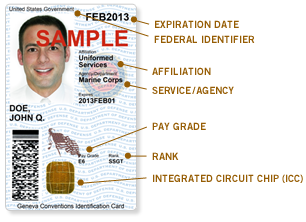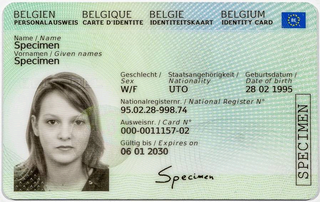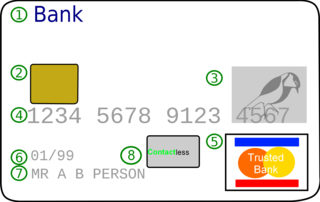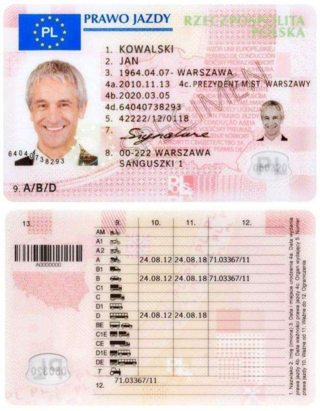An identity document is any document that may be used to prove a person's identity. If issued in a small, standard credit card size form, it is usually called an identity card, or passport card. Some countries issue formal identity documents, as national identification cards that may be compulsory or non-compulsory, while others may require identity verification using regional identification or informal documents. When the identity document incorporates a person's photograph, it may be called photo ID.
A national identification number, national identity number, or national insurance number or JMBG/EMBG is used by the governments of many countries as a means of tracking their citizens, permanent residents, and temporary residents for the purposes of work, taxation, government benefits, health care, and other governmentally-related functions.

The Common Access Card, also commonly referred to as the CAC, is a smart card about the size of a credit card. It is the standard identification for Active Duty United States Defense personnel, to include the Selected Reserve and National Guard, United States Department of Defense (DoD) civilian employees, United States Coast Guard (USCG) civilian employees and eligible DoD and USCG contractor personnel. It is also the principal card used to enable physical access to buildings and controlled spaces, and it provides access to defense computer networks and systems. It also serves as an identification card under the Geneva Conventions. In combination with a personal identification number, a CAC satisfies the requirement for two-factor authentication: something the user knows combined with something the user has. The CAC also satisfies the requirements for digital signature and data encryption technologies: authentication, integrity and non-repudiation.

A Belgian identity card is a national identity card issued to all citizens of Belgium aged 12 years old and above.
The Permanent Resident card is an identification document and a travel document for permanent residents of Canada. It is one of the methods by which Canadian permanent residents can prove their status and is, along with the permanent resident travel document (PRTD), one of the only documents that allow permanent residents to return to Canada by a commercial carrier.

The visa policy of Australia deals with the requirements that a foreign national wishing to enter Australia must meet to obtain a visa, which is a permit to travel, to enter and remain in the country. A visa may also entitle the visa holder to other privileges, such as a right to work, study, etc. and may be subject to conditions.

NEXUS is a joint Canada Border Services Agency and U.S. Customs and Border Protection-operated Trusted Traveler and expedited border control program designed for pre-approved, low-risk travelers. Members of the program can avoid waits at border entry points by using reserved lanes at land crossings into Canada and the United States, by using self-serve kiosks at airports in Canada, the US and some international locations, or by phoning border officials for a marine entry. A NEXUS membership card is a valid document under the Western Hemisphere Travel Initiative (WHTI), so it can be used in place of a passport, including by air if flying between the US and Canada. However, carrying a valid passport is still recommended, in the rare event that a flight is diverted to an airport without NEXUS support.

A travel document is an identity document issued by a government or international entity pursuant to international agreements to enable individuals to clear border control measures. Travel documents usually assure other governments that the bearer may return to the issuing country, and are often issued in booklet form to allow other governments to place visas as well as entry and exit stamps into them.

The United States passport card is an optional national identity card and a travel document issued by the U.S. federal government in the size of a credit card. Like a U.S. passport book, the passport card is only issued to U.S. nationals exclusively by the U.S. Department of State, compliant to the standards for identity documents set by the REAL ID Act, and can be used as proof of U.S. citizenship and identity. The passport card allows its holders to travel by domestic air flights within the U.S., and to travel by land and sea within North America. However, the passport card cannot be used for international air travel.

A credit card is a payment card issued to users (cardholders) to enable the cardholder to pay a merchant for goods and services based on the cardholder's accrued debt. The card issuer creates a revolving account and grants a line of credit to the cardholder, from which the cardholder can borrow money for payment to a merchant or as a cash advance. There are two credit card groups: consumer credit cards and business credit cards. Most cards are plastic, but some are metal cards, and a few gemstone-encrusted metal cards.

Every Polish citizen 18 years of age or older residing permanently in Poland is required to have an identity card issued by the local office of civic affairs. Children as well as Polish citizens living permanently abroad are entitled, but not required, to have one. Identity cards are valid for a period of 10 years.
Security Identification Display Area, or SIDA, is a special security area designated by an airport operator in the US to comply with Transportation Security Administration (TSA) requirements in CFR 49 1542.205. An identification system must be used in this area. Before allowing unescorted access to this area, a person must be trained and their background investigated. Normally, the flight ramp and other sensitive operational areas of a US commercial airport are designated as a SIDA.

The APEC Business Travel Card (ABTC) is a travel document issued to business travellers who are citizens of APEC participating economies. Valid for five years, the card eliminates the need for its holder to possess a visa when visiting other APEC participating economies as long as pre-clearance has been obtained during the application process.
The National Identity Card is the identity document in use in Sri Lanka. It is compulsory for all Sri Lankan citizens who are fifteen years of age and older to have their NICs. NICs are issued by the Department for Registration of Persons. The Registration of Persons Act No.32 of 1968 as amended by Act Nos 28 and 37 of 1971 and Act No.11 of 1981 legislates the issuance and usage of NICs.

The Citizen Card or CC is an identity card issued by the Portuguese government to its citizens. The card replaces several previous documents, including the Bilhete de Identidade, Social Security card, National Health Service card, Taxpayer card and voter registration card, in one secure card. The Citizen Card was first issued in the Azores in mid-2006.
The Lebanese identity card is a compulsory Identity document issued to citizens of the Republic of Lebanon by the police on behalf of the Lebanese Ministry of Interior or in Lebanese embassies/consulates (abroad) free of charge. It is proof of identity, citizenship and residence of the Lebanese citizens.

A driver's license is a legal authorization, or the official document confirming such an authorization, for a specific individual to operate one or more types of motorized vehicles—such as motorcycles, cars, trucks, or buses—on a public road. Such licenses are often plastic and the size of a credit card.
Australia does not have a national identity card. Instead, various documents may be used or required to prove a person's identity, whether for government or commercial purposes such as:
Digital identity is used in Australia by residents to validate who they are over digital media, such as over the Internet.

Automated border control systems (ABC) or eGates are automated self-service barriers which use data stored in a chip in biometric passports along with a photo or fingerprint taken at the time of entering the eGates to verify the passport holder's identity. Travellers undergo biometric verification using facial or iris recognition, fingerprints, or a combination of modalities. After the identification process is complete and the passport holder's identity is verified, a physical barrier such as a gate or turnstile opens to permit passage. If the passport holder's identification is not verified or if the system malfunctions, then the gate or turnstile does not open and an immigration officer will meet the person. E-gates came about in the mid-2000s as an automated method of reading the then-newly ICAO mandated e-passports.